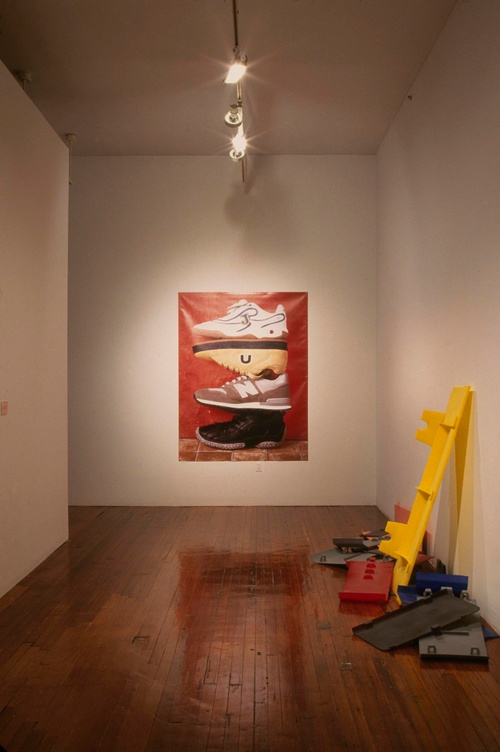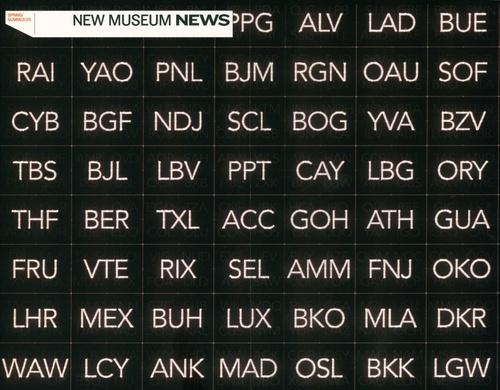José Antonio Hernández-Diez
José Antonio Hernández-Diez
All propaganda or popularization involves a putting of the complex into the simple, but such a move is instantly deconstructive. For if the complex can be put into the simple, then it cannot be as complex as it seemed in the first place; and if the simple can be an adequate medium of such complexity, then it cannot after all be as simple as all that.
-Terry Eagleton
Like the artist himself, who divides his time between Caracas, Venezuela, and Barcelona, Spain, the works of José Antonio Hernández-Diez are always in motion, exploring the continuum between celebration and critique of the systems and structures that shape our lives. He challenges us to question relationships between globalization and consumption; religion and technology; leisure time and productivity; activity and passivity; and even the distinctions between playfulness and violence. Rather than providing simple answers, the works encourage us to participate in and investigate how we define these systems and how they, in turn, define us. These relationships, and their impact on our sense of identity, are not always as clear-cut as we would like to believe.
Ideas about complexity and ambivalence connect the disparate works in this exhibition, Hernández-Diez’s first comprehensive museum presentation in the United States. The artist, trained as a filmmaker and videographer, created some of the earliest video works in his native Venezuela. From the beginning, Hernández-Diez confounded North American and European ideas about what Latin American art should look like. By mining the history of canonized Western contemporary art and using the international vocabulary of Pop art and minimalism, he refused to engage many of the stereotypes surrounding Latin American art, namely, that it is colorful, otherworldly, baroque. Rather than simply appropriating forms, Hernández-Diez twisted them to suit his own means, infusing huge commonplace objects such as spoons, fake fingernails, and battery covers with wit and social commentary while simultaneously dismantling the perceived power and might inherent in high minimalist works of the 1960s. Both the form and content of the work explore and exploit these contested spaces/interstices in art history as well as in society.
The use of unexpected juxtapositions first appears in his works from the early 1990s. In them, populist Catholic icons are revisited with the use of technology and modern medical science. The works, which seem respectful rather than sacrilegious, exemplify how the traditional and the modern can coexist. The sacred (artificial) heart continues to beat with the aid of technology; a washing machine cleanses you of dirt and sin; and a dog, venerated as a saint for its curative powers by a thirteenth-century French peasant population but not by the Catholic Church, can be touched by twenty-first-century viewers.
San Guinefort draws on the legend of a greyhound of the same name that sacrificed its life to a poisonous snake to save the infant of a wealthy landowner. Instead of an ornate medieval reliquary encrusted with jewels, we are presented with a simple Plexiglas case hooked up to a tank of nitrogen that houses a taxidermic mutt, the type of common street dog seen roaming the streets of Caracas. Is the artist suggesting that this surrogate can perform the same miracles witnessed by the French peasants? Thanks to the wonders of modern medicine (and modern art), you can slide your hands into the black rubber gloves and touch the saint yourself. Believe in these rituals and the miracles made possible by a marriage of science and technology-or don’t. The work simply provides a framework in which to make your own decisions about religion and science.
Hernández-Diez’s works also document some of the ways we spend our leisure time: skateboarding, shopping, playing pool, watching or playing sports. By allowing us to express ourselves, these activities shape our lives, our communities, and our personal identities. Although these activities may be relaxing, they can also highlight the competitive nature of sports as well as the links between physical strength, power, and violence. The artist uses games to explore societal power structures: the perpetual inability of the mechanized arm to make the pool shot; the fried-pork skateboards devoured by street dogs; and the use of baseball bats to manipulate our surroundings. Baseball, the consummate American pastime, is becoming more international, with more than a quarter of the players in the United States’ major leagues coming from the Dominican Republic, Puerto Rico, Venezuela, and Mexico. By making us cross from passive viewer to active participant in Untitled (Arroz con Mango) [Rice with Mango], Hernández-Diez encourages us to investigate some of these less-stable boundaries of the sports.
Untitled (Arroz con Mango) lets viewers step up to the plate. We can exert our own strength, show our physical prowess, or act out our aggressions by picking up a baseball bat and hitting the aluminum-topped cabinet. When hit, the work emits a noise, either a sound effect or a sample taken from television and radio broadcasts at the work’s current location. If you don’t like the sound, you change it by hitting the table again as others look on. There are few things in life where change is so easy to achieve-and yet we question at what price this change comes.
Hernández-Diez uses modified pPop and minimalist forms to explore the effects of globalization on both work and play. Many people spend their wages on electronics that promise to improve their quality of life and leisure time. Symbols of increased prosperity in many parts of the world, televisions, video and DVD players, home entertainment centers, battery-powered toys, and their remote controls can also beare signs of affluenza in places like the United States. For those addicted to materialism and overconsumption, it’s easy to buy another cheap electronic device made overseas if you’ve lost the remote control or its battery cover.
Battery covers are the detritus of consumer culture, hiding under our couch cushions. In an untitled work, Hernández-Diez enlarges these lost bits of plastic, making them impossible to miss. Although less recognizable than Andy Warhol’s Brillo boxes or Campbell’s soup cans, these non-branded battery covers are more ubiquitous than those pop icons of the 1960s. Hernández-Diez’s sculptures, which are modeled on actual battery covers, share several formal characteristics with high-minimalist works: they are constructed from industrial materials; they bear no trace of the artist’s hand; and they are propped against the wall or stacked on top of each other like some of Richard Serra’s most famous lead works. The combination of lightweight colorful acrylic and minimalist forms questions the power and authority often associated with such works as well asand the might of consumerism.
Minimalism’s muscle is also evident in Que te rinda el día [Have a productive day] but this time it is much more ominous. Rectangular forms with an embossed design are hung on the wall like minimalist paintings, propped against the wall, and converted into a desktop. Has the artist simply re-created a white-collar corporate office interior? In this interior, there’s nowhere to sit down to work. And the embossed designs on each surface are actually huge-though carefully executed-bite marks. Are these traces of the monster who must make sure we workers follow the instructions of the artwork’s title and “have a productive day”? Productivity, the hallmark of capitalism and globalization, allows corporations to increase their earnings but the workers themselves rarely see these profits. Perhaps these bite marks express our frustration about our working conditions or the pressure to work longer hours and be more productive or our attempts to gnaw our way out of corporate cages.
In addition to cheap labor, globalization relies on the production and consumption of goods. Our consumption patterns, like our relationships to religion, leisure, and work, also define our identities. Or so the advertising executives of Madison Avenue would have us believe. Using a variety of sneakers (from the expensive Hermès brand to cheap street-corner knockoffs), Hernández-Diez spells out the names of some of the most influential Western thinkers: Hume, Kant, Jung, and Marx. Hernández-Diez’s philosopher-footwear banners investigate two ways of forming identities: philosopher René Descartes’s “I think, therefore I am” meets artist Barbara Kruger’s “I shop therefore I am.” The works acknowledge the power of slick advertising techniques and our tendency, especially when younger, to create identities and communities based on clothing brands. Other brands, including McDonalds, Nike, and Starbucks, are just as familiar to many. Are Western intellectual juggernauts such as Hume, Kant, Jung, and Marx equally well known across the socioeconomic spectrum? What if we based our identities and our relationships on shared intellectual ideas? Would this be any less shallow? Perhaps the works are trying to use sneakers to make the Western philosophy of the last three centuries look hip, appealing, and relevant. Or perhaps they are using philosophy to help us examine our fascination with consumer culture, materialism, and consumption.
Hernández-Diez’s quirky works suggest multiple ways for thinking about religion, technology, identities, consumption, and globalization. The complexities of these power systems that shape our lives are revealed through deceptively simple-looking works. By presenting conflicting sides of issues, or systems that work against each other at times and in tandem at other times, the artist compels us to see how we uphold, benefit from, and are disempowered by these forces.
-Erin Barnett, Joanne Leonhardt Cassullo Curatorial Fellow





















